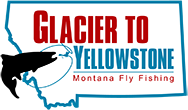Rods
If you are only able to bring one rod to Montana, you will want a 9ft rod in 5wt or 6wt. The 5wt is a great all around rod, while a 6wt is nice for bigger flies or if the wind kicks up. On smaller streams, 3wt or 4wt rods are fun, but you would struggle with these on larger rivers, especially when the wind comes up. These smaller weight rods generally should still be an 8ft or longer rod. There are many good brands available. A few of our favorites include Sage, Temple Fork, and Winston, but this is by no means a definitive list.
Lines
The vast majority of fishing in Montana is done with a weight forward, floating line. A sinking line can be useful for streamer fishing in rivers or for lake fishing.
Reels
A decent, middle of the road reel is all that is needed for trout fishing in Montana. High end reels are generally geared more towards saltwater fishing and are overkill for trout. All major fly fishing manufacturers build good reels for Montana.
Waders
I generally prefer chest high waders, although many anglers use waist high wading pants as well. Hip waders are inadequate for all but the smallest streams. Pair your waders with a good wading boot with felt or rubber soles. Avoid cleats or studs if you plan on fishing from a boat. During high summer, many anglers opt to wet wade and choose wading sandals or boots with wool socks.
Wading Staff
Wading staff's are nice on Montana's many swift rivers. They are also nice for inexperienced waders or those folks who desire a bit of extra stability.
Leaders
Tapered leaders between 7.5 and 9 feet will cover most situations. Most of your leaders should be 3x and 4x, you will want 2x or even 1x for big flies or dirty water. 5x can be useful for very small flies or spring creeks.
Tippet
Make sure to have 3x and 4x tippet in both nylon (for dry flies) and flourocarbon (for nymphing). As discussed above, you will want heavier tippet if you are going to be fishing big flies or dirty water, and lighter tippet for very small flies or spring creek.
Flies
Fly selection varies greatly between rivers and time of year. Below is a very basic guideline. You should consult a local fly shop or guide service before your trip for more specific information
Spring patterns:
Dries: size 16-18 blue winged olives, size 18 parachute adams, size 14 caddis in various colors including olive and tan
Nypmhs: san juan worms in various colors, 6-8 stonefly nymphs in brown and black, 14 16 pheasant tails, 12 14 prince nymph, 14 16 lightning bug
Early Summer
Dries: 14 16 caddis in olive and tan, 8 10 Chernobyl Ants in golden, tan, and brown, 4 6 salmonfly dry, 12 14 PMX or Royal Trude, 10 12 Turks Tarantula
Nypmhs: 6-8 stonefly nymphs in brown and black, 14 16 pheasant tails, 12 14 prince nymph, 14 16 lightning bug, 14 16 copper john, 4 6 zonker (or other streamer)
Late Summer - late July to mid September
Dries: 8 10 12 foam hopper, 8 10 12 Chernobyl Ant, 14 16 Purple Haze, 12 14 PMX, 14 16 flying ant
Nypmhs: 6-8 stonefly nymphs in brown and black, 14 16 pheasant tails, 14 16 hare's ear, 12 14 prince nymph, 14 16 lightning bug, 14 16 copper john, 4 6 zonker (or other streamer)
Late Fall - Late September - November
Dries: 16 18 blue winged olives, 18 20 midges, 10 12 hoppers, 14 16 ants
Nypmhs: san juan worms in various colors, 6-8 stonefly nymphs in brown and black, 14 16 pheasant tails, 12 14 prince nymph, 14 16 lightning bug, 18 20 zebra midge, 6 8 woolhead sculpin

